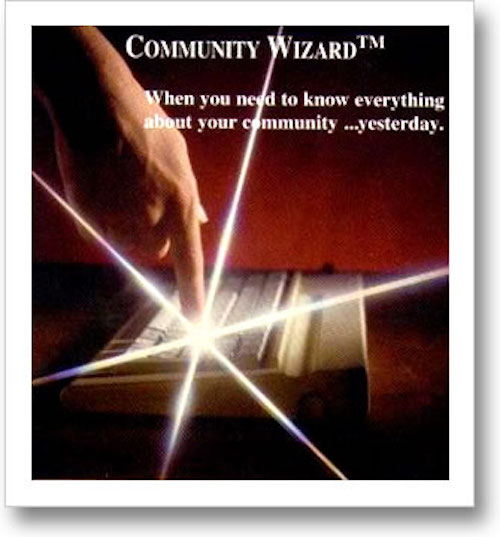
Community Wizard Software Tools stolen from Hamilton Securities by the Department of Justice and HUD Inspector General
Monday, 25 February 2002, 9:38 am
Column: Catherine Austin Fitts
By Catherine Austin Fitts
First published in the Narco News Bulletin
Originally Published Oct 2001
Narco Dollars For Dummies
Part 2 – Sam & Dave Do White Substances
Part 3 – The Ultimate New Business Cold Call
Part 4 – On Your Map
Part 5 – Getting Out of Narco Dollars
Part 6 – Georgie And West Philadelphia
Part 7 – Dow Jones Up, Solari Index Down
Part 9 – At the Heart of the Double Bind
Part 10 – Drugs as Currency
Part 11 – In Defense of American Drug Lords
Part 12 – We Have Met the Enemy and It is Us
Part 13 – The Real Deal: Americans Love A Winner
******
“Who can compete with the government?” – John Gotti, Jr.
The Hickory Valley-Philadelphia
Fast Food Franchise Pop
Two things helped me understand money laundering in America. First, as I drove from Hickory Valley to Philadelphia once a month and drove around the country with my dog Forest all sorts of people started to teach me about how the money worked – truckers and the ladies who run the brand-name motels and the folks who work the late shifts at the gas station food marts. Second, I read “Black Money”, a mystery novel by Michael Thomas, a former partner of the Wall Street firm, Lehman Brothers.
In “Black Money” a government investigator investigating S&L fraud starts to look into the revenues and expenses of a fast food chain, which is experiencing far more deposits from sales than it is selling pizzas. As Thomas walks you through a handful of the near infinite number of possible money laundering schemes known to mankind, you start to get a sense for some of the economics of fast food franchises that have nothing to do with feeding people.
After I finished “Black Money” I started to pay attention to “how the money works” at the fast food and motel franchises at every interstate exit between Tennessee and Philadelphia. What I noticed about them was that no matter when I drove by – day or night, weekday or weekend – some of them were suprisingly empty. Indeed, one or two name brands were defined by their perpetual emptiness. Conversations every time I stopped filled in a lot here and there about how much cash was coming in and going out on the food and retail business.
Some quick estimation on what was being spent per interstate exit to start up and operate all the retail establishments versus what was coming in the door in terms of legitimate business said that some businesses had to be an excuse – an excuse to generate stock market capital gains by combining laundered money or phony profits with retail franchises – or both.
The problems this presents to people trying to run an honest business are numerous. The problems it creates for our work ethic and culture are numerous too. It increasingly puts the low performance people in charge, and everyone starts to behave like and follow them.
For example, I drove ten miles to Bolivar, our county seat, one night to go through the car wash at the local big chain publicly traded gas station. I tried to pay for a three-dollar car wash with quarters. I was told they would not take coins. It was a policy. Counting coins was too much work, the person at the register and then the manager said as they sat and gossiped with their friends, no other customers in sight. So I got back in my car and drove ten miles home and washed the car with a hose and some paper towels, the symbolic economy being too busy to care about steady customers or to do the real work in the concrete world.
If you are feeling energetic, go drive around to a few areas with a heavy concentration of retail fast food and motel franchises. Try estimating out the numbers. See how they work for you in your place. Are your local businesses in the retail business or the money laundromat business or both?
Another quick and dirty estimation technique for your neighborhood is to take the Department of Justice’s figure of $500 billion- $1 trillion and divide by 281 million Americans for a “per American” estimate of money laundering market share. Now multiply that times the number of people in your area. Now divide by the number of local banks. What do the numbers say to you?
The next time you are out on the streets, see if you can guess where the money is. It’s bound to be there someplace.
(continues…)
…come back tomorrow for Part 9 – At the Heart of the Double Bind
– AUTHOR NOTE: Catherine Austin Fitts, author of Scoop’s “The Real Deal” column, is a former managing director and member of the board of directors of Dillon Read & Co, Inc, a former Assistant Secretary of Housing-Federal Housing Commissioner in the first Bush Administration, and the former President of The Hamilton Securities Group, Inc. She is the President of Solari, Inc, an investment advisory firm. Solari provides risk management services to investors through Sanders Research Associates in London.
Anti©opyright Solari 2002
